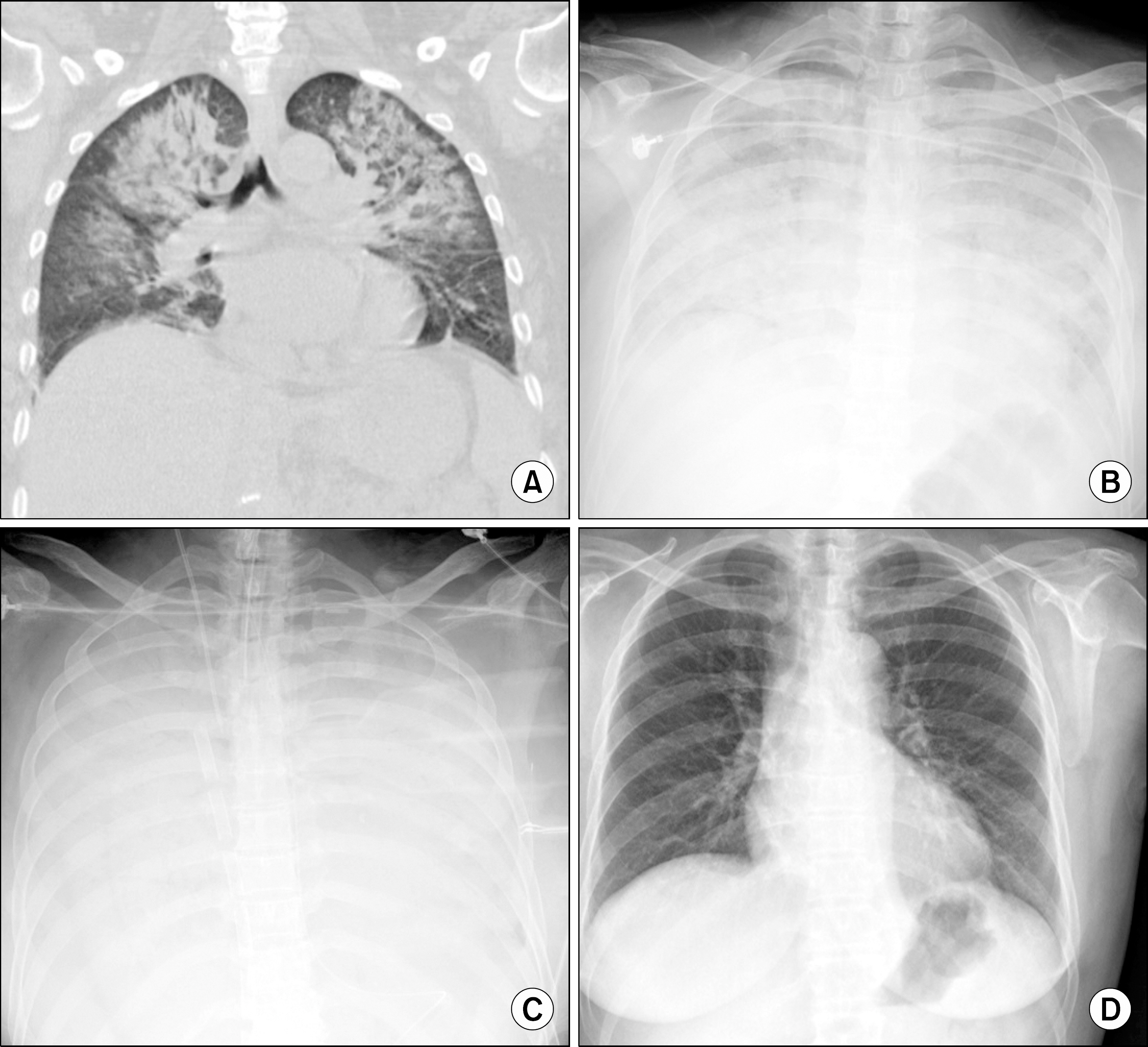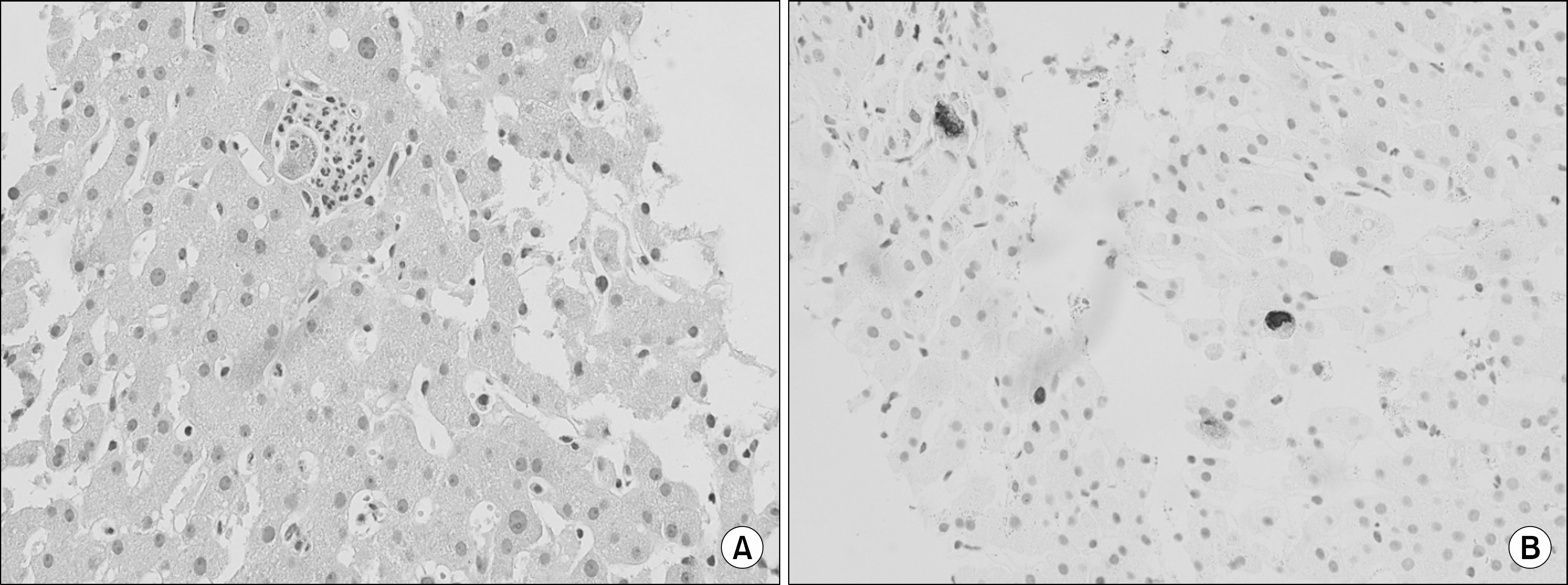J Korean Soc Transplant.
2017 Jun;31(2):75-81. 10.4285/jkstn.2017.31.2.75.
A Case Treated with Extracorporeal Membrane Oxygenation for Disseminated Cytomegalovirus Infection after Liver Transplantation
- Affiliations
-
- 1Division of Pulmonary and Critical Care Medicine, Department of Internal Medicine, Seoul National University Bundang Hospital, Seoul National University College of Medicine, Seongnam, Korea. lungdrcho@snubh.org
- 2Department of Surgery, Seoul National University Bundang Hospital, Seoul National University College of Medicine, Seongnam, Korea.
- 3Department of Thoracic and Cardiovascular Surgery, Seoul National University Bundang Hospital, Seoul National University College of Medicine, Seongnam, Korea.
- KMID: 2385532
- DOI: http://doi.org/10.4285/jkstn.2017.31.2.75
Abstract
- Cytomegalovirus (CMV) is a clinically important pathogen in immunocompromised patients, especially after organ transplantation. However, there have been several reports of severe CMV infections in immunocompetent patients. This report presents a case of an immunocompetent patient who presented with fulminant hepatitis requiring liver transplantation. Because CMV was detected upon histopathologic review of the explanted liver, it was later assumed that CMV may be the primary cause of hepatitis. However, at the time of transplantation, we did not suspect CMV hepatitis. Following transplantation and initiation of immunosuppression, the patient developed viral sepsis with a disseminated CMV infection. Respiratory failure because of CMV pneumonia worsened despite antiviral therapy, and venovenous extracorporeal membrane oxygenation (ECMO) was initiated. Although ECMO has been traditionally contraindicated in patients with sepsis, this patient recovered and was successfully weaned off ECMO. CMV should be included in the differential diagnosis of fulminant hepatitis, even in immunocompetent patients, especially when liver transplantation is considered.
MeSH Terms
Figure
Reference
-
1). Nguyen Q., Estey E., Raad I., Rolston K., Kantarjian H., Jacobson K, et al. Cytomegalovirus pneumonia in adults with leukemia: an emerging problem. Clin Infect Dis. 2001. 32:539–45.
Article2). Rafailidis PI., Mourtzoukou EG., Varbobitis IC., Falagas ME. Severe cytomegalovirus infection in apparently immunocompetent patients: a systematic review. Virol J. 2008. 5:47.
Article3). Wreghitt TG., Teare EL., Sule O., Devi R., Rice P. Cytomegalovirus infection in immunocompetent patients. Clin Infect Dis. 2003. 37:1603–6.
Article4). Brodie D., Bacchetta M. Extracorporeal membrane oxygenation for ARDS in adults. N Engl J Med. 2011. 365:1905–14.
Article5). Karagiannidis C., Brodie D., Strassmann S., Stoelben E., Philipp A., Bein T, et al. Extracorporeal membrane oxygenation: evolving epidemiology and mortality. Intensive Care Med. 2016. 42:889–96.
Article6). Haneke F., Schildhauer TA., Schlebes AD., Strauch JT., Swol J. Infections and extracorporeal membrane oxygenation: incidence, therapy, and outcome. ASAIO J. 2016. 62:80–6.7). Muller T., Lubnow M., Philipp A., Schneider-Brachert W., Camboni D., Schmid C, et al. Risk of circuit infection in septic patients on extracorporeal membrane oxygenation: a preliminary study. Artif Organs. 2011. 35:E84–90.8). Squizzato A., Gerdes VE., Buller HR. Effects of human cytomegalovirus infection on the coagulation system. Thromb Haemost. 2005. 93:403–10.
Article9). Kotton CN., Kumar D., Caliendo AM., Asberg A., Chou S., Danziger-Isakov L, et al. Updated international consensus guidelines on the management of cytomegalovirus in solid-organ transplantation. Transplantation. 2013. 96:333–60.
Article10). Ljungman P., Griffiths P., Paya C. Definitions of cytomegalovirus infection and disease in transplant recipients. Clin Infect Dis. 2002. 34:1094–7.
Article11). Lee SO., Razonable RR. Current concepts on cytomegalovirus infection after liver transplantation. World J Hepatol. 2010. 2:325–36.12). Yu YD., Park GC., Park PJ., Choi YI., Hwang S., Song GW, et al. Cytomegalovirus infection-associated fulminant hepatitis in an immunocompetent adult requiring emergency living-donor liver transplantation: report of a case. Surg Today. 2013. 43:424–8.
Article13). Shusterman NH., Frauenhoffer C., Kinsey MD. Fatal massive hepatic necrosis in cytomegalovirus mononucleosis. Ann Intern Med. 1978. 88:810–2.
Article14). Huang CT., Tsai YJ., Tsai PR., Ko WJ. Extracorporeal membrane oxygenation resuscitation in adult patients with refractory septic shock. J Thorac Cardiovasc Surg. 2013. 146:1041–6.
Article15). Cheng A., Sun HY., Lee CW., Ko WJ., Tsai PR., Chuang YC, et al. Survival of septic adults compared with nonseptic adults receiving extracorporeal membrane oxygenation for cardiopulmonary failure: a propensity-matched analysis. J Crit Care. 2013. 28:532. .e1-10.
Article16). Brechot N., Luyt CE., Schmidt M., Leprince P., Trouillet JL., Leger P, et al. Venoarterial extracorporeal membrane oxygenation support for refractory cardiovascular dysfunction during severe bacterial septic shock. Crit Care Med. 2013. 41:1616–26.17). Steinberg BE., Goldenberg NM., Lee WL. Do viral infections mimic bacterial sepsis? The role of microvascular permeability: a review of mechanisms and methods. Antiviral Res. 2012. 93:2–15.
Article18). Justo D., Finn T., Atzmony L., Guy N., Steinvil A. Thrombosis associated with acute cytomegalovirus infection: a meta-analysis. Eur J Intern Med. 2011. 22:195–9.
Article19). Schmidt M., Bailey M., Sheldrake J., Hodgson C., Aubron C., Rycus PT, et al. Predicting survival after extracorporeal membrane oxygenation for severe acute respiratory failure. The Respiratory Extracorporeal Membrane Oxygenation Survival Prediction (RESP) score. Am J Respir Crit Care Med. 2014. 189:1374–82.
Article20). Jain S., Self WH., Wunderink RG., Fakhran S., Balk R., Bramley AM, et al. Community-acquired pneumonia requiring hospitalization among U.S. adults. N Engl J Med. 2015. 373:415–27.
- Full Text Links
- Actions
-
Cited
- CITED
-
- Close
- Share
- Similar articles
-
- Extracorporeal Membrane Oxygenation for 67 Days as a Bridge to Heart Transplantation in a Postcardiotomy Patient with Failing Heart and Mediastinitis
- Successful Extracorporeal Membrane Oxygenation Support for Acute Pulmonary Thromboembolism during Adult Liver Transplantation
- Sequential Bilateral Lung Transplantation with Extracorporeal Membrane Oxygenation (ECMO) Support: A case report
- Anesthetic management including extracorporeal membrane oxygenation therapy of liver transplant recipient with life-threatening hypoxemia: a case report
- Successful Retrieval of a Fractured Guidewire during Extracorporeal Membrane Oxygenator Insertion




